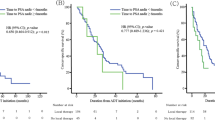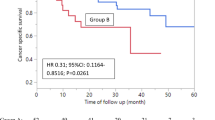Abstract
The purpose of this study was to identify the early predictor of survival for prostate cancer patients with bone metastasis. We reviewed 87 prostate cancer patients with bone metastasis who had received primary androgen deprivation therapy (PADT) at our institution. The medical records of the patients were examined with respect to laboratory data, pathological results, PSA response to PADT and clinical outcome. The overall survival (OS) rates were analyzed with reference to the nadir PSA level and time to PSA nadir (TTN) following PADT by Kaplan–Meier method. In all, 59 patients (67%) had progression to castration-resistant prostate cancer. Nadir PSA <0.2 ng ml–1 (lower PSA nadir) during PADT were observed in 47 patients (54%). Multivariate analysis revealed that the extent of disease on bone scan (P=0.04), lower PSA nadir following PADT (P=0.003), albumin (P=0.04) and lactate dehydrogenase (P=0.01) were independent prognostic factors for survival. OS rates in the patients with lower PSA nadir were significantly higher. Longer TTN (>9 months) identified patients with prolonged OS in both lower and higher PSA nadir groups. PSA nadir <0.2 ng ml–1 and prolonged TTN (>9 months) following PADT might be the most important early predictors for longer survival in prostate cancer patients with bone metastasis.
This is a preview of subscription content, access via your institution
Access options
Subscribe to this journal
Receive 4 print issues and online access
$259.00 per year
only $64.75 per issue
Buy this article
- Purchase on Springer Link
- Instant access to full article PDF
Prices may be subject to local taxes which are calculated during checkout



Similar content being viewed by others
References
Eisenberger MA, Carducci M . Treatment of hormone-refractory prostate cancer. In: Wein AJ, Kavoussi LR, Novick AC, Partin AW, Peters CA (eds) Cambell-Walsh Urology, Vol 3, 9th edn Sounders: Philadelphia, PA, 2007, 3101–3117.
De Voogt HJ, Suciu S, Sylvester R, Pavone-Macaluso M, Smith PH, De Pauw M, Members of the European Organization for Research on Treatment of Cancer Genitourinary Tract Cancer Cooperative Group. Multivariate analysis of prognostic factors in patients with advanced prostatic cancer: results from 2 European Organization for Research on Treatment of Cancer trials. J Urol 1989; 141: 883.
Isikawa S, Soloway MS, Van der Zwaag R, Todd B . Prognostic factors in survival free of progression after androgen deprivation therapy for treatment of prostate cancer. J Urol 1989; 141: 1139–1142.
Cooperberg MR, Hinotsu S, Namiki M, Ito K, Broering J, Carroll PR et al. Risk assessment among prostate cancer patients receiving primary androgen deprivation therapy. J Clin Oncol 2009; 27: 4306–43136.
Matzkin H, Soloway MS, Schellhammer PF, Chodac G, Smith JA, Caplan R et al. Prognostic factors in stage D2 prostate cancer treated with a pure non-steroidal antiandrogen. Cancer 1995; 72: 1055.
Matzkin H, Eber E, Todd B, van der Zwaag R, Soloway MS . Prognostic significance of changes in prostate-specific markers after endocrine treatment of stage D2 prostate cancer. Cancer 1992; 70: 2302–2309.
Kwak C, Jeong SJ, Park NS, Lee E, Lee SE . Prognostic significance of the nadir prostate specific antigen level after hormone therapy for prostate cancer. J Urol 2002; 168: 995–1000.
Sim HG, Lau WKO, Cheng CWS . Predictors of androgen independence in metastatic prostate cancer. BJU Int 2004; 93: 1221–1224.
Wilson DW, Harper ME, Jansen HM, Ikeda RM, Richards G, Peeling WB et al. A prognostic index for the clinical management of patients with advanced prostatic cancer: a British Prostate Study Group investigation. Prostate 1985; 7: 131–141.
Soloway MS, HardemanSW, Hickey D, Raymond J, Todd B, Soloway S et al. Stratification of patients with prostate cancer based on extent of disease on initial bone scan. Cancer 1988; 61: 195–202.
General Rule for Clinical and Pathological Studies on Prostate Cancer, the 3rd Edition, Japanese Urological Association. 2001.
Choueiri TK, Xie W, d'Amico AV, Ross RW, Hu JC, Pomerantz M et al. Time to prostate-specific antigen nadir independently predicts overall survival in patients who have metastatic hormone-sensitive prostate cancer treated with androgen-deprivation therapy. Cancer 2009; 115: 981–987.
Oefelein MG, Agarwal PK, Resnick MI . Survival of patients with hormone-refractory prostate cancer in the prostate specific antigen era. J Urol 2004; 171: 1525–1528.
Tomioka S, Shimbo M, Amiya Y, Nakatsu H, Murakami S, Shimazaki J . Outcome of patients with hormone-refractory prostate cancer: prognostic significance of prostate-specific antigen-doubling time and nadir prostate-specific antigen. Jap J Clin Oncol 2008; 38: 36–42.
Vollmer RT, Kantoff PW, Dawson NA, Vogelzang NJ . A prognostic score for hormone-refractory prostate cancer: analysis of two cancer and leukemia group B studies. Clin Cancer Res 1999; 5: 831–837.
Sylvester RJ, Denis L, de Voogt H, EORTC. The importance of prognostic factors in the interpretation of two EORTC metastatic prostate cancer trials. Eur Urol 1998; 33: 134–143.
Smaletz O, Scher H, Small EJ, Verbel DA, McMillan A, Regan K et al. Nomogram for overall survival of patients with progressive metastatic prostate cancer after castration. J Clin Oncol 2002; 20: 3972–3982.
Morote J, Esquena S, Abascal JM, Trilla E, Cecchini L, Raventos CX et al. Usefulness of prostate-specific antigen nadir as predictor of androgen-independent progression of metastatic prostate cancer. Int J Biological Markers 2005; 20: 209–216.
Hussain M, Tangen CM, Higano C, Schelhammer PF, Faulkner J, Crawford ED et al. Absolute prostate-specific antigen value after androgen deprivation is a strong independent predictor of survival in new metastatic prostate cancer: data from southwest oncology group trial 9346 (INT-016). J Clin Oncol 2006; 24: 3984–3990.
Hori S, Jabbar T, Kachroo N, Vasconcelos JC, Robson CN, Gnanapragasam VJ . Outcomes and predictive factors for biochemical relapse following primary androgen deprivation therapy in men with bone scan negative prostate cancer. J Cancer Res Clin Oncol 2011; 137: 235–241.
Arai Y, Yoshiki T, Yoshida O . Prognostic significance of prostate specific antigen in endocrine treatment for prostatic cancer. J Urol 1990; 144: 1415–1419.
Yeung F, Li X, Ellett J, Trapman J, Kao C, Chung LM . Regions of prostate-specific antigen (PSA) promoter confer androgen-independent expression of PSA in prostate cancer cells. J Biol Chem 2000; 275: 40846–40855.
Onishi T, Yamakawa K, Franco OE, Kawamura J, Watanabe M, Shiraishi T et al. Mitogen-activated protein kinase pathway is involved in alpha 6 integrin gene expression in androgen-independent prostate cancer cell: role of proximal Sp1 consensus sequence. Biochemica Biophysica Acta 2001; 14728: 1–10.
Acknowledgements
We thank Dr Tomomi Yamada (Department of Translational Medical Science, Mie University Graduate School of Medicine) for her assistant in statistical analyses, and Dr Omar E Franco (Department of Urologic Surgery, Vanderbilt University) for his help in the preparation of this paper.
Author information
Authors and Affiliations
Corresponding author
Ethics declarations
Competing interests
The authors declare no conflict of interest.
Rights and permissions
About this article
Cite this article
Sasaki, T., Onishi, T. & Hoshina, A. Nadir PSA level and time to PSA nadir following primary androgen deprivation therapy are the early survival predictors for prostate cancer patients with bone metastasis. Prostate Cancer Prostatic Dis 14, 248–252 (2011). https://doi.org/10.1038/pcan.2011.14
Received:
Revised:
Accepted:
Published:
Issue Date:
DOI: https://doi.org/10.1038/pcan.2011.14
Keywords
This article is cited by
-
Flare on [18F]PSMA-1007 PET/CT after short-term androgen deprivation therapy and its correlation to FDG uptake: possible marker of tumor aggressiveness in treatment-naïve metastatic prostate cancer patients
European Journal of Nuclear Medicine and Molecular Imaging (2023)
-
Prognostic factors, efficacy, and toxicity of involved-node stereotactic body radiation therapy for lymph node oligorecurrent prostate cancer
Strahlentherapie und Onkologie (2022)
-
Predictors of poor response to first-generation anti-androgens as criteria for alternate treatments for patients with non-metastatic castration-resistant prostate cancer
International Urology and Nephrology (2020)
-
Pre-treatment ratio of periprostatic to subcutaneous fat thickness on MRI is an independent survival predictor in hormone-naïve men with advanced prostate cancer
International Journal of Clinical Oncology (2020)
-
Effect of Prior Local Treatment and Prostate-Specific Antigen Kinetics during Androgen-Deprivation Therapy on the Survival of Castration-Resistant Prostate Cancer
Scientific Reports (2019)



